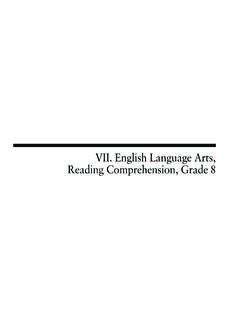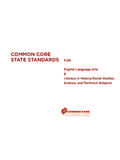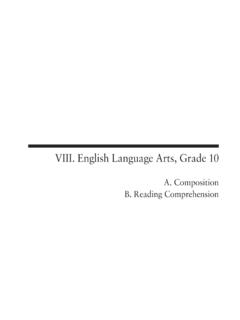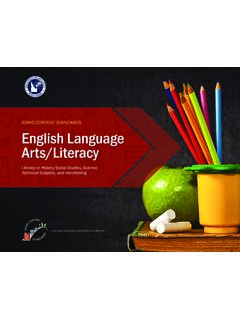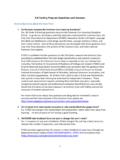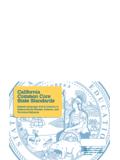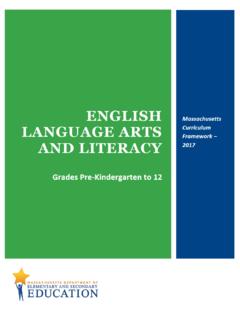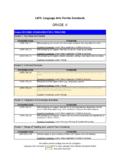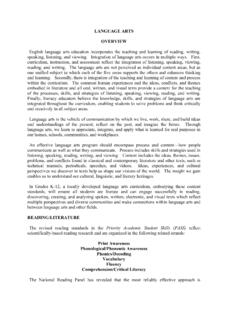Transcription of English/Language Arts Foundations - IACCRR
1 English/Language arts Foundations 33 Foundations to the Indiana Academic Standards for Young Children Foundations of English/Language arts Perhaps the most significant accomplishment a child makes during the first five years of life is acquiring language and using it to communicate. Infants first begin to communicate through crying, body movements, gestures, and facial expressions. As babies grow into toddlers and preschoolers, they attain a vocabulary of hundreds of words, and they learn how to use them to get what they need or want, to express their feelings, or to simply make conversation. While children do have the predisposition to learn languages, this does not happen without external intervention and support. Adults play a vital and irreplaceable role in a young child s speech development and literacy knowledge. Frequent interactions with young children, as well as providing opportunities to use (and witness the use of) written language in daily life, enable children to become competent readers, writers, speakers, and listeners.
2 Recent research has extended our understanding of how and when language is acquired and the critical importance of the early years. We have also gained a heightened appreciation of the adult s role in the success or failure of a child in becoming literate. It is of utmost importance that we as parents, teachers, and caregivers of young children gain an appreciation of the role we play as models and teachers of the language arts : speaking, listening, writing, and reading. Young children must have the opportunity to do more than simply learn to read and write; they need adults who provide experiences that make literacy enjoyable. Children should develop skills but should also have the disposition to become readers and writers. They must desire books. They must love words. Adults can help make this happen by making language pleasurable through reading aloud, singing songs, reciting playful poetry, and purposefully expose language for what it is an important and enjoyable part of our world.
3 Research has demonstrated that children with foundational skills of familiarity with print and books, the purposes of writing, and listening and speaking will be ready to benefit from reading instruction in school, learn to read sooner, and will be better readers than children with fewer of these skills (Strickland & Morrow, 2000; Whitehurst & Longman, 1998). English/Language arts Foundations 34 Foundations to the Indiana Academic Standards for Young Children KEY FINDINGS Infants are born hard-wired for language development because the ability to communicate is needed for their survival, but reading and writing must be taught (Snow & Burns, 1998). Children learn to talk, read, and write in progressive steps beginning at birth. Research studies indicate that what children learn from listening and talking will enhance or impede their emerging skills in reading and writing (Dickinson & Tabor, 2001; Head Start Bureau 2003; Strickland, 2004). Research on parents talking to their children suggests that the quantity of words, as well as the quality of word choice, influence children s language use, vocabulary development, and learning (Hart & Risley, 1995, 1999, 2004).
4 There is increasing recognition that literacy development starts long before children begin formal instruction in school and that later reading success is powerfully affected by the skills children acquire during these formative years. (NICHD, 2005). Research suggests that high quality preschool care and education can narrow the literacy achievement gap that is prevalent in many of our schools (Nisbett, 2010). Young children who demonstrate oral language skills and an understanding of print concepts have more success learning to read in kindergarten, first, second, and third grades (Scarborough, 2001). Adults who live and interact regularly with children can profoundly influence the quality and quantity of their literacy experiences. [National Research Council, 1998] Reading and writing are inseparable processes. [Ministry of Education, 1996; McCarrier, A. Pinnell, G., & Fountas, I., 2000; National Research Council, 1999] Reading, writing, speaking, listening, and thinking develop simultaneously as learners grow into literacy.
5 [McCarrier, A. Pinnell, G., & Fountas, I., 2000; International Reading Association (IRA)/National Association for the Education of Young People (NAEYC) 1998; National Research Council, 1999] Speaking and listening are the foundation skills for reading and writing. [National Center on Education and the Economy, 2001] A strong basis in a first language promotes school achievement in a second language . [Neuman, , Copple, C., & Bredekamp, S., (Eds.), 1999] English/Language arts Foundations 35 Foundations to the Indiana Academic Standards for Young Children GLOSSARY Alphabetic principle: The understanding that there is a relationship between letters and sounds ( , the word dog contains three letters and three corresponding sounds or phonemes). Comprehension: Understanding. Listening comprehension refers to spoken language , reading comprehension refers to written language . Decode: The ability to translate the alphabet letters into recognizable sounds ( , the letter f makes the /f/ sound) and words.
6 NOTE: /r/ - This symbol refers to the letter sound, not the letter name. Emerging Reading: The acquisition of those concepts concerning print, language , and the activities of reading and writing that provide the foundation for learning the skills of literacy. Expressive language : Children s accurate and fluent use and knowledge of words in the spoken language . Fluency: The ability to identify letters and words automatically and with speed. Letter Knowledge: The ability to identify the letters of the alphabet. Literacy: The ability to read and write and use language proficiently. Phoneme: The smallest part of spoken language that makes a difference in the meaning of words. english has about 41 phonemes. Most words have more than one sound or phoneme ( , big has three phonemes /b/ /i/ /g/). Sometimes one phoneme is represented by more than one letter ( , ck = /k/). Phonemic awareness is a subcategory of phonological awareness (see below). The focus of phonemic awareness is narrow identifying and manipulating the individual sounds in words.
7 Phonological Awareness The whole spectrum from an awareness of speech sounds: identifying and making oral rhymes; identifying and working with syllables in words; identifying and working with the beginning sound (onset) of a word and the part of the word following the beginning sound (rime); and identifying and working with individual phonemes in words (phonemic awareness). Phonics: The relation between letters and sounds in written words or an instructional method that teaches children these connections. Print-Rich Environment: an environment in which reading and writing are used for a wide variety of authentic, everyday purposes. Receptive language : Children s listening vocabulary and knowledge of spoken words. Symbol: Something visible that by association represents something else, restaurant logo. Vocabulary: The words of which one has listening and speaking knowledge. English/Language arts Foundations 36 Foundations to the Indiana Academic Standards for Young Children REFERENCES AND RESOURCES Annie E.
8 Casey Foundation (2010). Early warning! Why reading by the end of third grad matters: A KIDS COUNT Special Report. Retrieved from Bardige, , & M. Segal (2000). Building Literacy with Love: a guide for teachers and caregivers of children from birth through age 5. Washington, DC: Zero to Three Press. Bennett-Armistead, , Duke, , Moses, (2005). Literacy and the Youngest Learner. New York, NY: Scholastic. Blair, C., Protzko, J., & Ursache, A. (2011). Self-regulation and early literacy. In Neuman & Dickinson (Eds.), Handbook of early literacy research, Vol. 3. New York, NY: Guilford Press. Bredekamp, S. & Copple, C. (1997). Developmentally appropriate practice in early childhood programs. NAEYC Burns, S., Griffin. P., & Snow, C. (1999). Starting out right: A guide to promoting children s reading success. National Research Council. Burns, , Griffin, Pl, & Snow, (1999). Starting out right: A guide to promoting children s reading success. Washington, DC: National Academies Press DeBruin-Parecki, A.
9 , Perkinson, K., & Ferderer, L. (2000). Helping your child become a reader. Washington, DC: USDOE. Hart, B. & Risley, T. (1995). Meaningful differences in everyday experience of young American children. Baltimore: Brookes. Hart, B. & Risley, T. (1999). The social world of children learning to talk. Baltimore: Brookes. International Reading Association. (2000). Beginning reading and writing. International Reading Association(IRA)/National Association for the Education of Young People (NAYEC) (1998). Learning to read and write: Developmentally appropriate practices for young children. The Reading Teacher, (52)2. Kliewer, C. (2008). Seeing all kids as readers: a new vision for literacy in the inclusive early childhood classroom. Baltimore, MD: Brookes Martens, P. (1996). I already know how to read: A child s view of literacy. Portsmouth, NH: Heinemann. McCarrier, A. Pinnell, G., & Fountas, I. (2000). Interactive Writing. Portsmouth, NH: Heinemann. English/Language arts Foundations 37 Foundations to the Indiana Academic Standards for Young Children Miels, Jill C.
10 Abby bear deserves to be heard: Setting early writers free. Young Children, Vol. 56, Num. 2, March 2001. Ministry of Education. (1996). Dancing with the pen: The learner as a writer. Wellington, New Zealand: Learning Media. National Research Council & National Institute on Literacy. (2000). Reading: Knowing what works. National Research Council. (1998). Neuman, , Copple, C. & Bredekamp, S. (2000). Learning to read and write: Developmentally appropriate practices for young children. Washington, DC: NAEYC. Shickedanz, (1999). Much more than the ABCs: The early stages of reading and writing. Washington, DC: NAEYC. Snow, , Burns, , & Griffin, P. (Eds.). (1998). Preventing reading difficulties in young children. Washington, DC: National Academy Press. Zigler, , Singer, & Bishop-Josef, (Eds.) (2004). Children s play: The roots of reading. Washington, DC: Zero to Three Press. English/Language arts Foundations 38 Foundations to the Indiana Academic Standards for Young Children English/Language arts Standard Area COMMON CORE STATE STANDARD: Reading Standards: Foundational Skills Phonological Awareness ISTAR-KR: Demonstrates Awareness of Sounds Phonological awareness is an ear skill.

